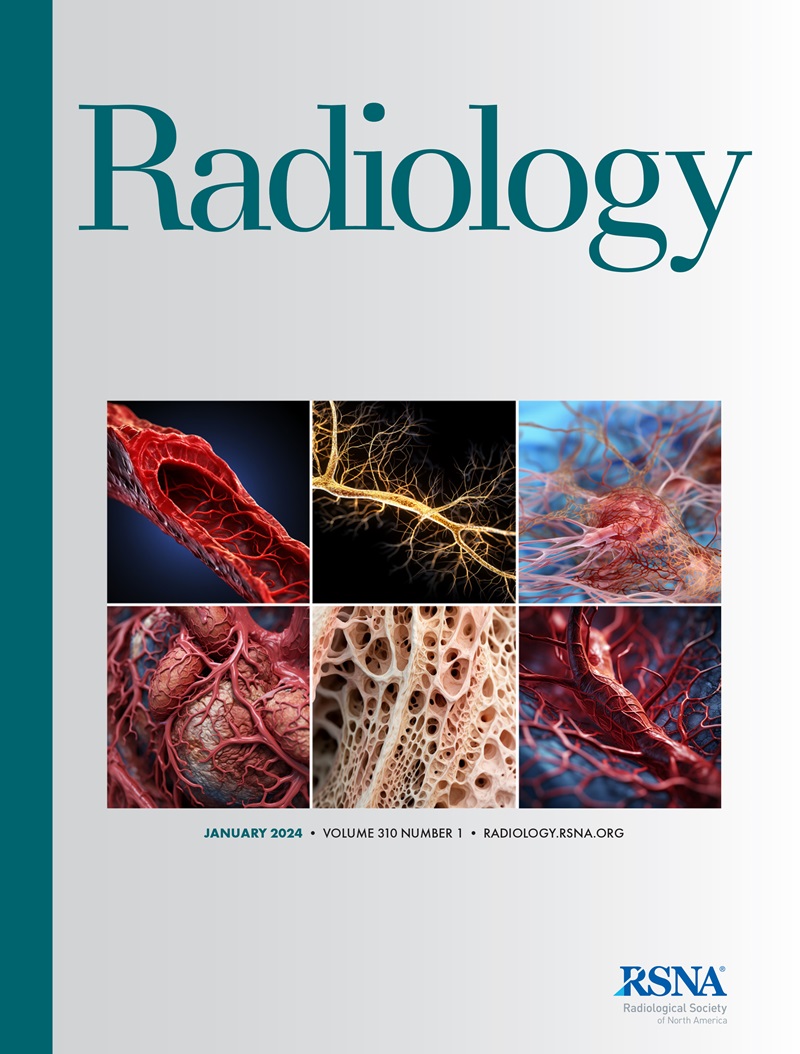Diagnostic Accuracy of Screening Contrast-enhanced Mammography for Women with Extremely Dense Breasts at Increased Risk of Breast Cancer.
Noam Nissan, Christopher E Comstock, Varadan Sevilimedu, Jill Gluskin, Victoria L Mango, Mary Hughes, R Elena Ochoa-Albiztegui, Janice S Sung, Maxine S Jochelson
下载PDF
{"title":"Diagnostic Accuracy of Screening Contrast-enhanced Mammography for Women with Extremely Dense Breasts at Increased Risk of Breast Cancer.","authors":"Noam Nissan, Christopher E Comstock, Varadan Sevilimedu, Jill Gluskin, Victoria L Mango, Mary Hughes, R Elena Ochoa-Albiztegui, Janice S Sung, Maxine S Jochelson","doi":"10.1148/radiol.232580","DOIUrl":null,"url":null,"abstract":"<p><p>Background Mammogram interpretation is challenging in female patients with extremely dense breasts (Breast Imaging Reporting and Data System [BI-RADS] category D), who have a higher breast cancer risk. Contrast-enhanced mammography (CEM) has recently emerged as a potential alternative; however, data regarding CEM utility in this subpopulation are limited. Purpose To evaluate the diagnostic performance of CEM for breast cancer screening in female patients with extremely dense breasts. Materials and Methods This retrospective single-institution study included consecutive CEM examinations in asymptomatic female patients with extremely dense breasts performed from December 2012 to March 2022. From CEM examinations, low-energy (LE) images were the equivalent of a two-dimensional full-field digital mammogram. Recombined images highlighting areas of contrast enhancement were constructed using a postprocessing algorithm. The sensitivity and specificity of LE images and CEM images (ie, including both LE and recombined images) were calculated and compared using the McNemar test. Results This study included 1299 screening CEM examinations (609 female patients; mean age, 50 years ± 9 [SD]). Sixteen screen-detected cancers were diagnosed, and two interval cancers occured. Five cancers were depicted at LE imaging and an additional 11 cancers were depicted at CEM (incremental cancer detection rate, 8.7 cancers per 1000 examinations). CEM sensitivity was 88.9% (16 of 18; 95% CI: 65.3, 98.6), which was higher than the LE examination sensitivity of 27.8% (five of 18; 95% CI: 9.7, 53.5) (<i>P</i> = .003). However, there was decreased CEM specificity (88.9%; 1108 of 1246; 95% CI: 87.0, 90.6) compared with LE imaging (specificity, 96.2%; 1199 of 1246; 95% CI: 95.0, 97.2) (<i>P</i> < .001). Compared with specificity at baseline, CEM specificity at follow-up improved to 90.7% (705 of 777; 95% CI: 88.5, 92.7; <i>P</i> = .01). Conclusion Compared with LE imaging, CEM showed higher sensitivity but lower specificity in female patients with extremely dense breasts, although specificity improved at follow-up. © RSNA, 2024 See also the editorial by Lobbes in this issue.</p>","PeriodicalId":20896,"journal":{"name":"Radiology","volume":"313 1","pages":"e232580"},"PeriodicalIF":12.1000,"publicationDate":"2024-10-01","publicationTypes":"Journal Article","fieldsOfStudy":null,"isOpenAccess":false,"openAccessPdf":"https://www.ncbi.nlm.nih.gov/pmc/articles/PMC11535862/pdf/","citationCount":"0","resultStr":null,"platform":"Semanticscholar","paperid":null,"PeriodicalName":"Radiology","FirstCategoryId":"3","ListUrlMain":"https://doi.org/10.1148/radiol.232580","RegionNum":1,"RegionCategory":"医学","ArticlePicture":[],"TitleCN":null,"AbstractTextCN":null,"PMCID":null,"EPubDate":"","PubModel":"","JCR":"Q1","JCRName":"RADIOLOGY, NUCLEAR MEDICINE & MEDICAL IMAGING","Score":null,"Total":0}
引用次数: 0
引用
批量引用
Abstract
Background Mammogram interpretation is challenging in female patients with extremely dense breasts (Breast Imaging Reporting and Data System [BI-RADS] category D), who have a higher breast cancer risk. Contrast-enhanced mammography (CEM) has recently emerged as a potential alternative; however, data regarding CEM utility in this subpopulation are limited. Purpose To evaluate the diagnostic performance of CEM for breast cancer screening in female patients with extremely dense breasts. Materials and Methods This retrospective single-institution study included consecutive CEM examinations in asymptomatic female patients with extremely dense breasts performed from December 2012 to March 2022. From CEM examinations, low-energy (LE) images were the equivalent of a two-dimensional full-field digital mammogram. Recombined images highlighting areas of contrast enhancement were constructed using a postprocessing algorithm. The sensitivity and specificity of LE images and CEM images (ie, including both LE and recombined images) were calculated and compared using the McNemar test. Results This study included 1299 screening CEM examinations (609 female patients; mean age, 50 years ± 9 [SD]). Sixteen screen-detected cancers were diagnosed, and two interval cancers occured. Five cancers were depicted at LE imaging and an additional 11 cancers were depicted at CEM (incremental cancer detection rate, 8.7 cancers per 1000 examinations). CEM sensitivity was 88.9% (16 of 18; 95% CI: 65.3, 98.6), which was higher than the LE examination sensitivity of 27.8% (five of 18; 95% CI: 9.7, 53.5) (P = .003). However, there was decreased CEM specificity (88.9%; 1108 of 1246; 95% CI: 87.0, 90.6) compared with LE imaging (specificity, 96.2%; 1199 of 1246; 95% CI: 95.0, 97.2) (P < .001). Compared with specificity at baseline, CEM specificity at follow-up improved to 90.7% (705 of 777; 95% CI: 88.5, 92.7; P = .01). Conclusion Compared with LE imaging, CEM showed higher sensitivity but lower specificity in female patients with extremely dense breasts, although specificity improved at follow-up. © RSNA, 2024 See also the editorial by Lobbes in this issue.
对乳房极度致密、罹患乳腺癌风险较高的女性进行乳房 X 线造影检查的诊断准确性。
背景 对于乳房密度极高(乳腺成像报告和数据系统 [BI-RADS] D 类)的女性患者来说,乳房 X 线造影的判读具有挑战性,因为她们患乳腺癌的风险较高。对比增强乳腺 X 光造影术(CEM)最近已成为一种潜在的替代方法;然而,有关 CEM 在这一亚人群中的实用性的数据还很有限。目的 评估 CEM 在极致密乳房女性患者乳腺癌筛查中的诊断性能。材料与方法 该回顾性单机构研究纳入了 2012 年 12 月至 2022 年 3 月期间对无症状的极致密乳房女性患者进行的连续 CEM 检查。CEM检查的低能量(LE)图像相当于二维全视野数字乳腺X光检查。使用后处理算法构建了突出对比度增强区域的重组图像。使用 McNemar 检验计算并比较了 LE 图像和 CEM 图像(即包括 LE 和重组图像)的敏感性和特异性。结果 这项研究包括 1299 次 CEM 筛查(609 名女性患者;平均年龄为 50 岁 ± 9 [标码])。诊断出 16 例筛查出的癌症,2 例间期癌症。在 LE 成像检查中发现了 5 例癌症,在 CEM 检查中又发现了 11 例癌症(癌症检出率增加,每 1000 次检查中发现 8.7 例癌症)。CEM灵敏度为88.9%(18例中有16例;95% CI:65.3, 98.6),高于LE检查的灵敏度27.8%(18例中有5例;95% CI:9.7, 53.5)(P = .003)。然而,与 LE 成像(特异性为 96.2%;1246 例中有 1199 例;95% CI:95.0, 97.2)相比,CEM 特异性有所下降(88.9%;1246 例中有 1108 例;95% CI:87.0, 90.6)(P < .001)。与基线时的特异性相比,CEM随访时的特异性提高到90.7%(777例中的705例;95% CI:88.5,92.7;P = .01)。结论 与 LE 成像相比,CEM 对极度致密乳房女性患者的敏感性较高,但特异性较低,尽管随访时特异性有所提高。RSNA, 2024 另请参阅本期 Lobbes 的社论。
本文章由计算机程序翻译,如有差异,请以英文原文为准。


